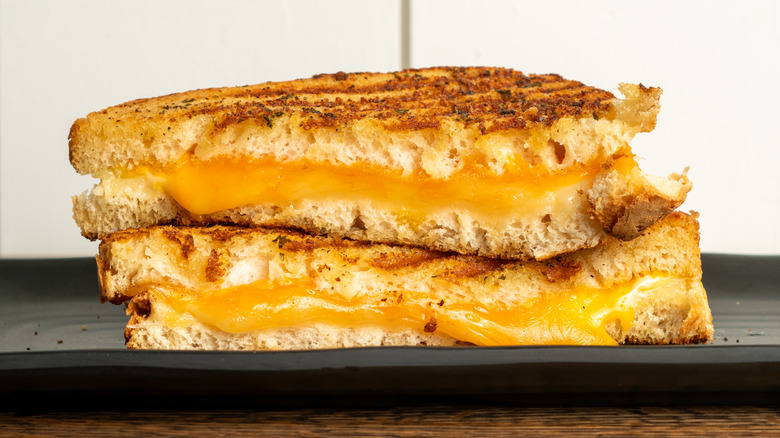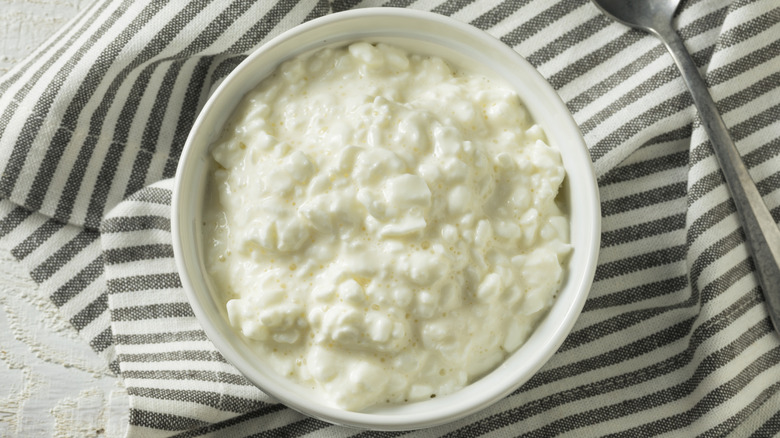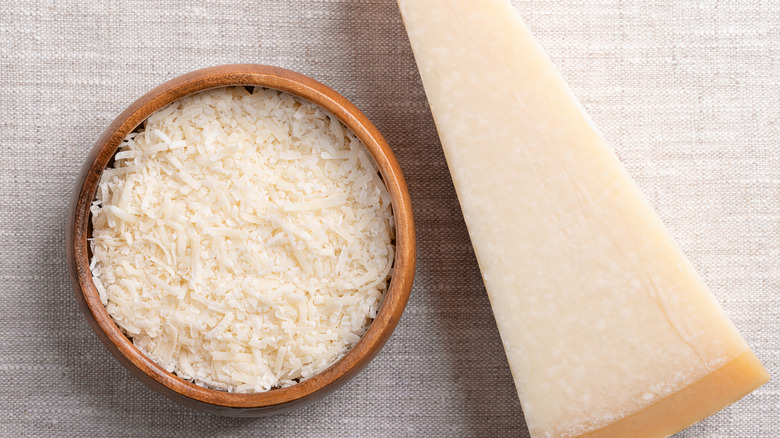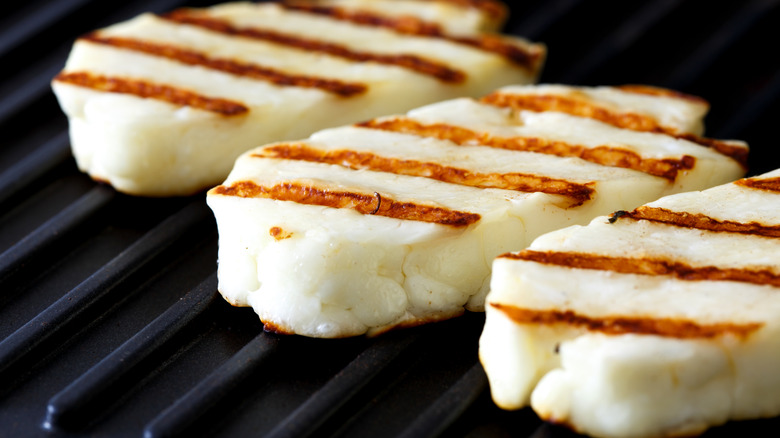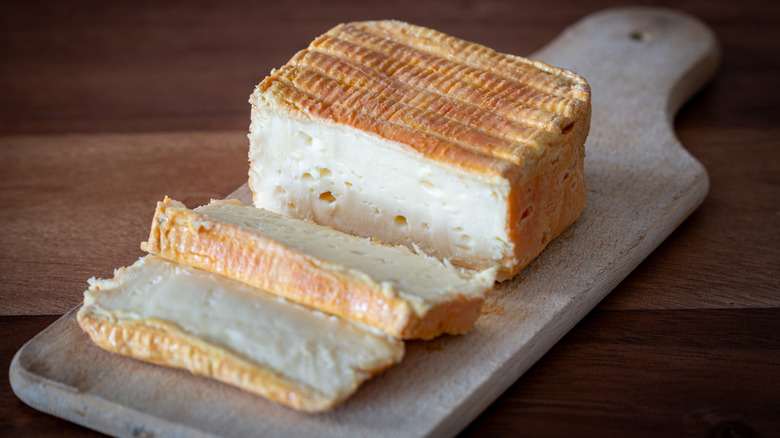The Worst Cheeses To Use For A Grilled Cheese Sandwich
Grilled cheese sandwiches may be one of America's classic comfort foods, but when I was a kid, I really didn't care for them. As it turns out, this was merely a byproduct of my dislike of American cheese (which continues to this day) — way back when, this seemed to be the only kind anyone ever used in sandwiches. When I grew up, however, I discovered that there are better cheeses for a perfectly melty grilled cheese sandwich, like cheddar, pepper jack, and provolone. Still, not every cheese is suitable. One of the biggest grilled cheese sandwich mistakes you can make involves a poorly chosen main ingredient.
Of course, the number one cheese to avoid is whatever kind you don't like. Still, there are other factors to take into consideration, since both the texture and flavor of the cheese need to work well in a sandwich. While all of the cheeses on this list have their place, it's not between two slices of toast. (Dishonorable mention goes to casu marzu, a worm-filled Sardinian cheese delicacy that didn't make the list because it has been banned in Italy since 1962, and who'd want to look at a picture of it anyway?
Cottage cheese
Cottage cheese seems to be having a moment right now, mostly for health-related reasons. It's particularly popular with the protein-obsessed and can be used to make low-carb chips or keto-friendly cloud bread. It can also be eaten on its own — or with ketchup, which was said to have been Richard Nixon's favorite breakfast. One thing you can't do with it, however, is to make a grilled cheese sandwich. The main reason is that it lacks the necessary structure. It's not going to melt into a gooey cheese pull; it will simply soak through your bread and make a soggy mess.
Another reason why cottage cheese doesn't have what it takes as a sandwich ingredient is that it has very little flavor of its own. Sure, you can always enhance your grilled cheese sandwich with additions such as bacon or kimchi, but the right cheese won't need any embellishments. Melted cheddar on toast is delightful all by itself (it's one of my favorite lazy-time meals), but the combination of cottage cheese and bread is nothing more than a culinary snoozefest.
Parmesan
Parmesan cheese, along with other hard cheeses like Asiago and Pecorino Romano, could be considered cottage cheese's polar opposite, but it is an equally poor choice for making grilled cheese sandwiches. Here, the problem isn't that the cheese is soft and wet but rather that it's dry and crumbly. There's simply too little fat or moisture to allow it to melt, so it will just sit in your sandwich like a layer of cheesy-tasting grit.
Before anyone starts protesting that parmesan does have a place in grilled cheese sandwiches, yes, I'm aware of this, but not as a filling. Your main cheese needs to be a melty one, but grated parmesan or a similar cheese can be mixed into the butter or mayonnaise used to coat the outside of the sandwich. The addition of one of those fatty ingredients will allow it to melt just enough to form a cheesy crust that will make your grilled cheese taste divine.
Halloumi
Halloumi, a cheese originating in Cyprus, has become quite popular because of a unique property: It holds its shape when cooked, thanks to an additional processing step in which the compressed curds are essentially poached in the whey that was drained out of them. This makes halloumi the cheese of choice for cooking over direct heat, and European Burger Kings have even sold fried halloumi burgers. This non-meltiness, however, means that halloumi is a terrible choice for a grilled cheese sandwich.
But wait, let's qualify that last sentence. Yes, a traditional sandwich made of toasted bread and melted cheese is not in the cards if you use halloumi. You can, however, use it for true grilled cheese, meaning cheese that you cook on the grill. Oil a slab of halloumi, throw it on the grates, and grill it on both sides. Slap it on a slice of bread (or between two buns, BK-style), and you have a grilled cheese sandwich of a different sort. (No photogenic cheese pull, though.)
Strong and stinky cheeses
My antipathy towards American cheese stems in part from the fact that I find it bland and flavorless compared to cheeses like cheddar, but when it comes to grilled cheese sandwiches, you can have too much of a good thing. The entire blue cheese family (gorgonzola, Roquefort, Stilton, and so on) is very strong-tasting, which is why it works so well as a topping for steaks and salads. In a concentrated dose such as a sandwich filling, though, the funky flavor is too overwhelming.
Limburger is another cheese that absolutely doesn't belong in a sandwich. This stinkiest of cheeses is very definitely an acquired taste, and one that not too many people manage to acquire. As one Redditor describes it, "It was terrible. I wanted to give it a chance, but nope ... I read it tasted great, but it was like rotting mushrooms." Another person didn't mind the initial flavor but said, "There's this biting, astringent aftertaste that I can't get behind." Supposedly, Limburger sandwiches are a stinky staple in Wisconsin, but I've lived in the state for the best part of a decade, and I've yet to see — or smell — them (for which I am most grateful). Even if Wisconsin-based Culver's starts selling Limburger burgers, though, I'm still going to nope out of this not-so-great state tradition.
Brunost
This last-named cheese may not be familiar to anyone who hasn't either traveled to Scandinavia or lived in a Scandinavian neighborhood, but brunost is oddly popular in Norway. Okay, I'll admit that the word "oddly" is a bit biased, but I spent a year at a Norwegian folk high school where it appeared every day at both breakfast and lunch. I tried it but absolutely hated the stuff and found it to be one of the odder foods I've ever eaten. (Norwegian bread, on the other hand, is amazing, and Lillehammer has the best-tasting water I've encountered anywhere.)
Let me backtrack for a moment and explain what brunost is and why it's not great for grilled cheese (in my opinion). The name translates to "brown cheese," and in appearance, it's somewhat similar to dulce de leche. It's actually a byproduct made from whey, not a proper cheese, and it has a sweet flavor that some compare to caramel. To me, however, there are plastic-like overtones that make it more akin to sugary Silly Putty. Norwegians admit that brunost is, well, polarizing, in the same way that Marmite and durian also have both defenders and detractors. Even its fans, though, find it to have a rather un-cheese-like flavor, which is one reason you might not want to use it in a grilled cheese sandwich. Another is that it has a rather soft texture, which won't hold up as well as more solid cheeses.
